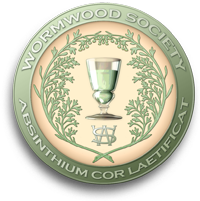
Absinthe: The Rise, Fall and Resurrection of the Green Fairy
Absinthe Inferred
Absinthe Feared
So how did absinthe gain its notoriety? What led to this drink being banned almost globally? Politics, of course.
At first absinthe was a fairly expensive commodity, indulged in primarily by the upper middle class, but by the latter part of the 1800’s several factors collided to bring absinthe into strong competition with wine as the national beverage—in a country famous for, and economically dependent upon, its wine.
At the time, wine was known to be natural and healthy and hence, spirits produced from wine—eau de vie, marc, brandy—were thought to be healthier and superior to less expensive spirits produced from beet sugar or grains. For this reason, absinthe producers preferred grape spirits to other alcohol. Whether grape spirits produce a better absinthe remains a topic for debate among absintheurs today.
When a phyloxera (tiny, aphid-like root lice) epidemic decimated the grape crops of France toward the end of the 19th century, wine prices—and hence, grape spirits prices—soared. Most manufacturers of absinthe switched to the cheaper alcohols out of economic necessity while others—most notably Pernod Fils—used the fact that they continued to use grape spirits to assert that their product was healthier as well as superior to that of their competitors. This also justified continuing to charge premium prices for premium absinthe. The effect of all this was that suddenly many absinthes were cheaper than wine, and at a much higher proof.
No longer exclusively the drink of the upper classes, absinthe was more accessible to the working man and in particular, as we well know, the “bohemians.” The bohemians were self-impoverished artists, writers, musicians, free-thinkers and counter-culture types—essentially the beatniks, hippies, or punks of the era. These are the “famous absinthe drinkers” we hear so much about: Rimbaud, Verlaine, Toulouse-Lautrec, Satie, Debussy, Van Gogh, Gauguin, etc.
Bohemianism was actually something of a movement, peopled with “cultural gypsies” who had seceded from the conventional lifestyle in pursuit of “Truth, Beauty, Freedom and Love” as it was so aptly put in Baz Luhrmann’s Moulin Rouge. The term bohemian was used because at the time it was erroneously believed that gypsies had originally come from Bohemia.
Although it no doubt approached the status of a sacrament to many of these figures, absinthe has become particularly associated with them more than others simply because it was they who chronicled its role in their lives and work; lives and work which were extraordinary enough to merit a place in history.
With the ubiquity of inexpensive absinthe, the bohemians, and nearly everyone else, indulged themselves enthusiastically; so enthusiastically in fact that alcoholism began to be a serious problem in France.
At the same time, less scrupulous manufacturers were cutting corners even further by adding poisonous adulterants such as copper sulfate for coloring and antimony chloride to enhance the “louche.” These no doubt contributed in part to the reported harmful effects of absinthe and it is perhaps because of this that the gathering enemies of absinthe coined a whole new social disease: absinthism.
